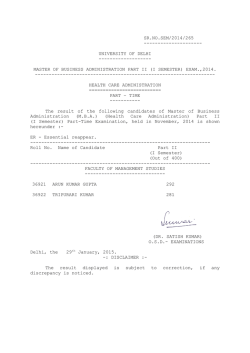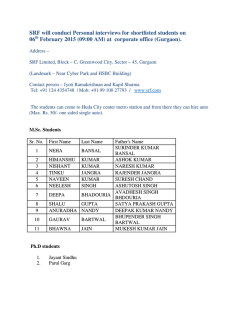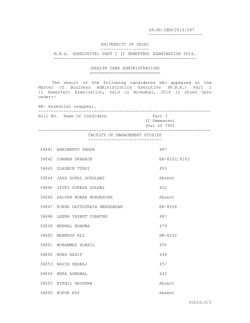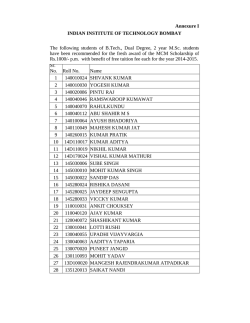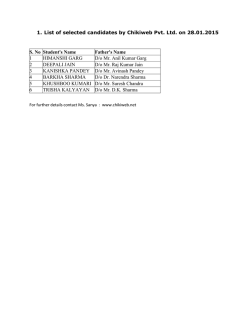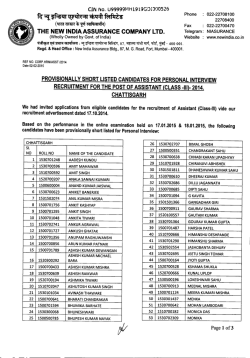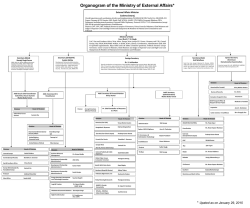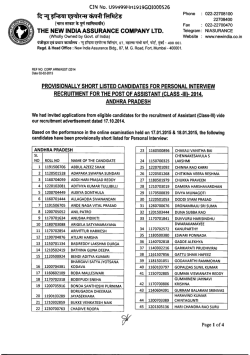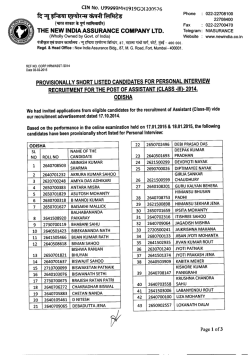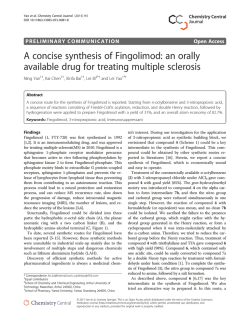
Synthesis and antimicrobial studies of fused heterocycles
Available online www.jocpr.com Journal of Chemical and Pharmaceutical Research, 2015, 7(1):710-714 Research Article ISSN : 0975-7384 CODEN(USA) : JCPRC5 Synthesis and antimicrobial studies of fused heterocycles ‘pyrimidobenzothiazoles’ Gulshan Kumar*, Praveen Kumar Sharma, Silky Sharma and Simranjeet Singh Department of Chemistry, Lovely Professional University, Phagwara, Punjab-India _____________________________________________________________________________________________ ABSTRACT In the present work 2H-Pyrimido[2,1-b]benzothiazole-2-ones were synthesized by reacting 2-aminobenzothiazoles with alkynoic acid in butanol and 4H-Pyrimido[2,1-b]benzothiazole-4-ones were synthesized by the reaction of 2aminobenzothiazoles with ethylacetoacetate in presence of polyphosphoric acid. The structures of synthesized compound were confirmed by IR, H1NMR & mass spectrum analysis. Synthesized compounds shown biological activity against E. coli and B. Subtilis and anti-fungal activity against A. fumigates. Keywords: 2-aminobenzothiazoles, 2-methyl-4H-pyrimido[2,1-b]benzothiazol-4-ones, 4-methyl-2H-pyrimido[2,1b]benzothiazol-2-ones, alkynoic acid _____________________________________________________________________________________________ INTRODUCTION Fusion of one heterocyclic system with other biodynamic heterocyclic system results in a molecule with structural diversity and with enhanced pharmacological activity. The fusion of hetero-systems has proved to be an attractive and useful method to design new molecular framework of therapeutically interest. With the objective of exploring new heterocycles, we had synthesized pyrimidobenzothiazoles [1-11], by incorporating two pharmacologically interesting heterocyclic systems; benzothiazole and pyrimidine. Pyrimidobenzothiazole are nitrogen–sulphur containing compounds that have been reported to exhibit a wide spectrum of activities such as GABA receptor binding agents [12,13], antiviral, antitumour, anti-inflammatory, analgesic, anticonvulsant, muscle relaxant, sedative [14-17], etc. During the past few decades, interest has been rapidly growing in the properties and transformations of this sulphur-nitrogen heterocycles [18-21]. In the present investigation we had synthesize derivatives of pyrimidobenzothiazoles from 2-aminobenzothiazole [22-24] and screened for biological activity. All the melting points are uncorrected. The purity of the synthesized compounds was checked by thin layer chromatography using mixture of different proportions of polar and non-polar solvents. The infrared spectra were recorded in KBr on SHIMADZU-8400S FTIR, 1H NMR spectra were recorded on an AV500 FT spectrometer operating in DMSO/CDCl3 mixture with TMS as an internal reference. The physical data of the all synthesized compounds are given in table-1. EXPERIMENTAL SECTION Synthesis of substituted 2H-Pyrimido[2,1-b]benzothiazole-2/4-ones 0.0033mole 2-amino-6-bromo/chloro/methoxybenzothiazole or 2-aminobenzothiazole and 0.0033mole propiolic acid were refluxed in 6ml butanol for about 22-23 hours and then filtered. The obtained solid were recrystallized. 710 Gulshan Kumar et al J. Chem. Pharm. Res., 2015, 7(1):710-714 ______________________________________________________________________________ The reaction mechanism has been given in Scheme-1. The structures of the synthesized heterocycles have been confirmed by their spectral characteristics. + NH2 R S H S N NH2 N O - OH 1 H C R = H,Cl,Br,OCH3 R OH C R 2 O S R S + N NH N -H2O O O N - OH H 3 (a - d) H Scheme-1 0.0033mol 2-aminobenzothiazole or 2-amino-6-methoxybenzothiazole and 2ml of ethylacetoacetate were refluxed in presence of polyphosphoric for 5 hours and then filtered. The obtained solid were recrystallized. The reaction mechanism has been given in Scheme-2. The structures of the synthesized heterocycles have been confirmed by their spectral data. CH3 N + NH2 O R S R H3CH2CO R=H, OCH3 R N O 4 R PPA NH O - OCH2CH3 HO S NH O OCH2CH3 CH3 O - O H3CH2CO N N - H2O H3CH2CO O O + NH2 S CH3 S 5 N H3C CH3 CH3 N + NH - CH3CH2O N - R R 6 (a - b) Scheme-2 Synthesis of 8-Bromopyrimidobenzothiazole-2-ones (3a) Yield- 70%, Melting point- 300-3100C, IR (KBr), 1637cm-1 (C=O) 1568cm-1 (C=C) 1587cm-1 (C=N), MS: m/z peak at 282(M+) (100%) is base peak. The other peaks (m/z, I > 5%) relating to the fragments are: 150,165,203,230.9, 240.9, 254.9, 283.9, 284.9. Synthesis of 8-Chloropyrimidobenzothiazole-2-ones (3b) Yield- 72%, Melting point: 3000C, IR (KBr) 1650cm-1 (C=O) 1568cm-1 (C=C) 1600cm-1 (C=N), MS: m/z peak at 237 (M+) (100%) is the base peak and different fragmentations appear at 239, 259, 222, 240, 275, 185, 166 are proving the synthesis. 711 Gulshan Kumar et al J. Chem. Pharm. Res., 2015, 7(1):710-714 ______________________________________________________________________________ Synthesis of pyrimido [2,1-b]benzothiazol-2-one (3c) Yield-33.3%, Melting point: 180-1900C Thin Layer Chromatography solvent is CHCl3: Hexane (6:4). Retention factor value for 2-aminobenzothiazole- 0.78 and for product is 0.60. Synthesis of 8-methoxy-pyrimido [2,1-b]benzothiazol-2-one (3d) Yield- 21.7%, Melting point: >3000C Thin Layer Chromatography solvent is Diethylether: Hexane (7:3). Retention factor value for 2-amino-6-methoxybenzothiazole is 0.75 for product is 0.62. Synthesis of 4H-pyrimido [2,1-b]benzothiazol-4-ones (6a) Yield-69%, Melting point: 140-1470C Thin Layer Chromatography solvent is Dichloromethanee. Retention factor value for 4H-pyrimido[2,1-b]benzothiazol-4-ones is 0.5 Synthesis of 8-methoxy-4H-pyrimido[2,1-b]benzothiazol-4-one (6b) Yield-63%, Melting point: 150-1600C Thin Layer Chromatography solvent is Dichloromethanee. Retention factor value for 8-methoxy-4H-pyrimido[2,1-b]benzothiazol-4-one is 0.6 Antibacterial activity: The all synthesized pyrimidobenzothiazoles were investigated for their activity against bacterial and fungal strains. The anti-bacterial tests were conducted on two common microorganisms such as Basillus subtilis and Escherichia coli, which are the representative type of gram-positive and gram-negative organism respectively and anti fungal test, were conducted on one microorganism that specially used in lawns. The agar media prepared by using following ingredients Nutrient agar Distilled water 16 g 500 ml Pentose dextrose agar Distilled water 17.5 g 500 ml Weighed-quantity of nutrient agar mix in the 500 ml distilled water to dissolve the agar solution. For complete dissolution the solution was heated in hot oven. Then the prepared nutrient agar media was sterilized by autoclave at 120˚C for 20 minutes at 15lbs/ in2 pressure. Preparation of test solution: 10 mg test compound were dissolved in 10 ml ethanol. From this 1ml solution was taken and dilute to 10 ml with ethanol. Now the concentration of test compound was 100 ppm or µg/ml. These sample solution were made in labeled sterilized test tubes. Preparation of standard solution: The standard drug used for testing was Gentamicin (G20) for anti bacterial and Flucanazole (FLC25) for anti fungal. The concentration of these drugs was adjusted to 100µg/ml. The sterilized media was cooled with gentle shaking to bring about uniform cooling. This was poured into sterilized Petri dishes and allows the media to set. The entire process of media pouring and inoculation was completed in laminar air flow unit. Then the discs which are previously prepared carefully kept on the solidified media by using sterilized forceps. These Petri dishes kept at room temperature for 1 hr and then for incubation at 37˚C for 24 hrs in incubator. The zone of inhibition was measured after 24 hrs for antibacterial and for antifungal after 4-5 days and result shown in table-2. RESULTS AND DISCUSSION The structures of the newly synthesized pyrimido [2,1-b]benzothiazol-2/4-ones were confirmed by spectral studies. The IR spectra of the synthesized compounds had shown characteristic absorption bands due to C=N, amidic C=O, and C=C stretching vibrations. The absorption band in range 1550–1600 cm-1 are due to C=N stretching vibrations and the absorption band in the region 1500–1550 cm-1 is assigned due to C=C stretching vibrations. The absence of stretching vibrations of the –NH2 group and appearance of absorption band in the region 1680–1710 cm-1 corresponding to the C=O group of cyclic amide suggest that the heterocyclization has occurred. The m/z peak at 282 (M+) confirm the synthesis of (3a) and 237 (M+) confirm the synthesis of (3b). Thin layer chromatography data (Rf value) also confirm the synthesis of 3c, 3d, 6a and 6b. 712 Gulshan Kumar et al J. Chem. Pharm. Res., 2015, 7(1):710-714 ______________________________________________________________________________ Table-1 Physical data of synthesized compounds S. No. 1 2 3 4 5 6 Compound 3a 3b 3c 3d 6a 6b Molecular formula C10H5BrN2OS C10H5ClN2OS C10H6N2OS C11H8N2O2S C11H8N2OS C12H10N2O2S M.Pt. ºC 300-310 300 180-190 220-225 140-147 150-160 %Yield 70 72 33.3 21.7 69 63 Table-2 Antibacterial activities of the compounds S. No. Compound 1 2 3 4 5 3c 3d 6a 6b Standard B. subtilis (10ppm) 8±1(32%) 24.3±2.5 Zone of inhibition (in mm) Antibacterial activity Antifungal activity B. subtilis E.coli A. fumigates A. fumigates (100ppm) (100ppm) (50ppm) (50ppm) 1.6± 0.57(14.3%) 3.3± 0.57(28.6%) 7± 2(35%) 4± 2.6(20%) 2.6± 0.57(15%) 25±3 19±2 13.6±1.52 13.6± 1.52 CONCLUSION In conclusion a new series of substituted pyrimido[2,1-b]benzothiazol-2-ones and 4-ones derivatives has been synthesized and evaluated for their anti microbial activities. Most of the new compounds shown appreciable activities. Acknowledgement We are thankful to Punjab University, Chandigarh and Guru Nanak dev university Amritsar for providing the mass spectrum and 1HNMR spectrum. REFERENCES [1] HN Al Jallo; MA Muniem, Journal of heterocyclic chemistry, 1978, 15, 849. [2] S Swarup; KS Rangappa, European Journal of Medicinal Chemistry; 2009, 44, 1223–1229. [3] A Santagati; M Santagati; F Russo; G Ronsisvalle, Journal of heterocyclic chemistry, 1988, 25, 949-953. [4] JJ Wade; RF Hegel; CB Toso, The Journal of Organic Chemistry, 1979, 44, 1811-1816. [5] RM Acheson; DJ Wallis, Journal of Chemical Society Perkin Trans, 1982, 1, 1905. [6] GJS Doad; D Okor; F Schenmann, Journal of Chemical Society Perkin Trans, 1988, 1, 2993. [7] C Landreau; D Deniaud; M Evain; A Reliquet; JC Meslin, Journal of Chemical Society Perkin Trans, 2002, 1, 741-745. [8] H Wahe; JT Mbafor; AE Nkengfack; ZT Fomun; RA Cherkasov; O Sterner; D Doepp, ARKIVOC, 2003, 15, 107114. [9] H Muller; MU Kassack; M Wiese, Journal Bimolecular Screening, 200 4, 9, 506. [10] KG Baheti; SN Kapratwar; SV Kuberkar, Synthetic Communications (UK), 2002. 32 (14): 2237-2243. [11] MA Metwally; EI Desoky; R Fawzy; HA Etman; SS Ketene, Chemistry of Heterocyclic Compounds, 2007, 43, 382–386. [12] X Wang; J Ai; H Wahe; ZT Fomum; O Sterner; M Nielsen; MR Witt, Pharmacology, 2000, 60, 175–178. [13] G Trapani; M Franco; A Latrofa; A Carotti; G Genchi; M Serra; G Biggio; G Liso, European Journal of Medicinal Chemistry, 1996, 31, 575-587. [14] F Russo; G Romeo; A Caruso; V Cutuli; D Amore, European Journal of Medicinal Chemistry, 1994, 29, 569– 578. [15] MMM Gineinah, Scientia Pharmaceutica, 2001, 69 (1), 53-61. [16] R Arpana; N Siddiqui; SA Khan, Journal of Pharmaceutical Science, 2007, 69, 10–17. [17] SR Nagarajan; GA De Crescenzo; DP Getman, HF Lu; JA Sikorski; JL Walker; JJ McDonald; KA Houseman; GP Kocan; N Kishore; PP Mehta; CL Funkes-Shippy; L Blystone, Bioorganic & Medicinal Chemistry, 2003, 11 (22), 4769-4777. [18] AK Fogla; V Ankodia; PK Sharma; M Kumar, Research on Chemical Intermediates, 2009, 35, 35–41. 713 Gulshan Kumar et al J. Chem. Pharm. Res., 2015, 7(1):710-714 ______________________________________________________________________________ [19] V Ankodia; PK Sharma; V Gupta; M Kumar, Heterocyclic Communication, 2008, 14, 155-160. [20] BS Rathore; M Kumar, Bioorganic & Medicinal Chemistry, 2006, 14, 5678-5682. [21] RR Gupta; M Kumar, Chemical and Biomedical Aspects Elsevier, Amsterdam, 1988, 1–161. [22] G Kumar; V Gupta; DC Gautam; RR Gupta, Heterocyclic Communication, 2002, 8 (5), 447-450. [23] G Kumar; V Gupta; DC Gautam; RR Gupta, Heterocyclic Communication, 2002, 8 (4), 381-384. [24] G Kumar; V Gupta; DC Gautam; RR Gupta, Phosphorus, Sulfur, and Silicon and the Related Elements, 2004, 10, 1941-1948. 714
© Copyright 2026
